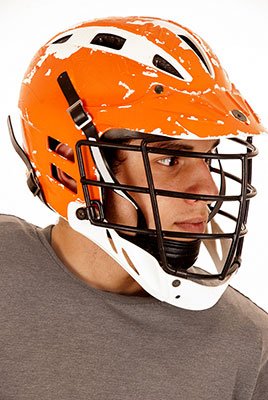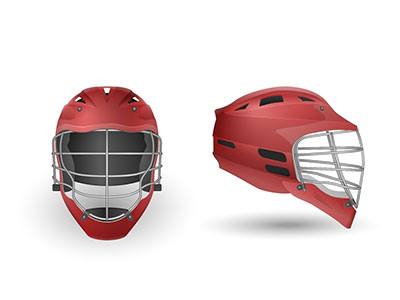Are you a lacrosse player in the class of 2023 looking to customize your helmet? Spicing up the look of your helmet can be an exciting and creative way to express yourself on the field.
One popular route towards personalization is through spray painting - but do you know how to get started properly?
Whether for game day, practice, or fun, this guide will help ensure you have everything covered regarding how to spray paint a lacrosse helmet!
More...
Take Away Key Points:
How to apply helmet decals properly? The ultimate guide
Below you can find the best guidelines when painting your own helmet. Ensure you read the guide thoroughly to help you paint your helmet effectively.
1. Should you paint your lacrosse helmet?
Lacrosse players have a lot of decisions to make when choosing lacrosse equipment. Still, one thing is sure: Painting your lacrosse helmet is a great way to customize the look of your helmet and show off individual expression.
On top of that, lacrosse helmets are intended to serve a functional purpose as well by protecting from lacrosse-related head injuries. So, it's important to choose a paint that won't interfere with the protective qualities of your helmet.
There are lacrosse-specific paints available on the market. The paints are designed to correctly adhere to lacrosse helmets and give you peace of mind knowing that your lacrosse helmet has been effectively painted. Your helmet will still maintain its protective properties.
Ultimately, lacrosse players should research and ensure they get the suitable materials to paint their helmets for the best result!

2. What should you use to paint the helmet?
Painting a lacrosse helmet should be done with care and precision. Many lacrosse players prefer lacquer paint since it is durable and can give you more vibrant, sharper colors.
However, this paint type requires access to a spray gun and takes a few days to dry completely. For the less experienced lacrosse player looking for an easier solution, craft acrylic paints are available in smaller packages that can be applied without a spray gun.
It's best to buy lacrosse helmet-approved paint, as it will make sure your custom helmet is waterproof and won't wear away after time or extensive use on the field.
3. When is the right time to paint your helmet?
Painting a helmet is a great way to show your style and give it an individualized flare. It's best to paint a brand-new helmet if at all possible, as the coating on the outside is more likely to remain intact even after being exposed to extreme conditions.
If you decide to paint an already worn-out helmet, it might not retain its original look due to the damage already done, so the paint may not last very long and could detract from the overall safety of the helmet.
Overall, it is probably worth investing in a new or used helmet before opting to paint one.
4. Can you paint all helmets equally?
Painting a helmet requires more skill and patience than many people realize. Depending on the helmet's material, the technique for painting it may vary slightly.
Moreover, not all helmets are suitable for painting in the same manner - complicated designs may require different forms of preparation. Additionally, certain paints can provide better durability and nicer finishes than others when used on helmets.
Therefore, while it may be possible to paint all helmets equally, it is best to consult a skilled professional with experience in protective gear before attempting a do-it-yourself venture if the pre-printed versions are too expensive for you.
5. How do you paint your lacrosse helmet?
Below you can find the best guide before you begin painting and the entire procedure for excellent results. Let's start.
Step 1: Find the design you like
Designing the helmet is a creative task that requires a great deal of precision and skill. Therefore, players should consider a few things when choosing their helmet design.
Color scheme, artwork size, and the materials' quality can all add up to create a fantastic painted helmet. Researching available designs and considering how the style meets the team color scheme help players decide the best design for painting their helmets.
Additionally, working with experienced lacrosse designers and artists can be incredibly beneficial in creating a unique helmet that will surely get noticed on the field!
Step 2: Find the best tools for painting a helmet

Players have the unique opportunity to express their creativity while they customize their helmets with paint. There are two main ways to do so: using paint markers or spray paint.
Paint markers are great for creating intricate details, allowing players to add color and create mesmerizing designs using several different water-based acrylic paints.
Spraying paint might be more efficient at covering a large area of the outer shell more quicker. Players can also get creative and combine masking tape and spray paint to create complex patterns! Spray paint might be a better option to coat the whole helmet.
All tools should be used as players see fit; however, following the recommended approach will make things easier.
Step 3: Preparing the helmet
Before players dive into the fun part of painting their lacrosse helmets, the first step is taking good care of them by giving them a good clean.
Taking the time to remove decals and adhesives from the outer and inner layers of the helmet is always a great idea to ensure that no gunky residue gets in the way of achieving a smooth paint finish.
Finally, give the actual helmet a thorough wash, wipe, and dry it off thoroughly with a clean towel to avoid any dirt, dust, or lint from getting stuck onto the finished product. Players will be thankful for this extra effort when they get to wear their artfully painted helmets with pride.
Step 4: Primer comes first
Players might find themselves wondering how they can adequately care for their helmets. Sanding and painting the helmet is a great way to revive its look.
Removing removable parts, such as a face mask, a visor, trim, plastic parts, and chain straps, taping off the interior with painter's tape, and stuffing materials inside the helmet are all essential steps to take before getting started.
To get the gloss off, lacrosse players want to sand it with 400 grit sandpaper or higher - don't sand it into the shell material to avoid scratches.
After sanding and rinsing, lacrosse players should prime their helmets with a flat white primer if the color is not already white. Players might need multiple coats of water-based paints after it dries from the primer, depending on their desired outcome color.
Following these steps carefully helps players keep their lacrosse helmets in great condition!
Step 5: Applying spray paint for a clear coat
After thoroughly priming your lacrosse helmet, you can start painting your masterpiece. Make sure to find a well-ventilated area with no objects or gear you don't want to get accidentally ruined.
When using spray paint, paint a thin layer, work from at least one foot away, and apply broad strokes to apply an even coat. Keep repeating this until proper coverage is achieved.
This way, lacrosse players can customize their helmets responsibly and with minimal risk of ruining any valuable equipment. But, of course, you might need to repeat the painting process a few times to get even color, a clear coat, and a good painting.
Step 6: Finishing the painted surface
The final step is to apply clear coats on board, light, or strokes. The clear coat should dry each time, and you should add paint to make an even coat each time.
Finally, once the painted surface and the clear coat have completely dried, you can add a glossy finish to the surface and make the helmet shine. It will look cool and powerful while wearing your helmet. The finish can be sprayed with polyurethane on the final coat to protect the paint and add a touch of shine to your shell.
You can also add various stickers for a complete process and make your helmet look cool on the outside.
6. How to paint motorcycle helmets?
Painting a motorcycle helmet is almost identical to a lacrosse helmet. Painting a motorcycle helmet can be a great way to add some personal flair to your ride.
Whatever design you have in mind, whether it be flames, stripes, abstract art, comic book or game characters, stickers, or something unique to you, all you need are some basic supplies and a little bit of creativity!
Before you start painting the helmet itself, make sure to prep it properly with sandpaper and degreaser so that the paint will adhere well. Then use masking tape or painter's tape to create any patterns or shapes on the surface.
When it is time to paint, acrylic paints are often best because they are inexpensive and come in many colors. A clear coat can protect your design from chips and fading too. Remember to take your time during each step for the best results!
7. How can you paint a football helmet?
Painting the helmet is a great way to customize your team's equipment or even to design a unique piece of art. The procedure is almost identical to lacrosse helmets.
To begin, you will need to gather all the necessary supplies: a football helmet, some aerosol primer, an aerosol paint color of your choice, and a clear acrylic coat.
Before applying any paint, make sure to clean the helmet with soap and water to remove dirt. Then use the primer to prep the surface and fill in any scratches or dents.
Once that is finished and fully dry, it's time for you to start adding color! Pro-tuff decals and stickers are good options for American football helmets.
Let each coat of paint dry thoroughly before using as many coats as needed till you are satisfied with the coverage.
Finally, finish your masterpiece by adding a few coats of clear acrylic coat to protect the head equipment and make the plastic shine. Enjoy showing off your newly painted helmet!
FAQs
Can you wrap a lacrosse helmet?
Yes, you can wrap a helmet. Companies like JackWraps, DecalGuyz, HeadWrapz, Pro-Tuff Decals, SportDecals, and SchoolPride offer pre-designed and fully customized lacrosse helmet wraps and decals. You can also find lacrosse helmet decals on Amazon.
Does putting stickers on your helmet weaken it?

It is generally safe to put stickers or vinyl cutouts on your helmet. However, there are some things you should take into account before making your decision. The adhesive used to stick the sticker to the helmet can cause a chemical reaction with the helmet material, which can weaken its structure.
Additionally, some helmets may be vulnerable to damage from the adhesives that back stickers and decals. Therefore, it is crucial to consider these factors before putting stickers on your helmet to avoid any potential damage.
How to put on lacrosse helmet decals?
Applying lacrosse helmet decals is a simple process that can be done in a few easy steps. First, align the decal so that it will be level with the player's head when the helmet is worn.
Next, slowly peel the decal from its backing and carefully avoid wrinkling or tearing it. Then, locate the area where you wish to place the decal and lightly press it into place.
Finally, use a squeegee to press down on the decal and ensure that it firmly adheres to the helmet.
Conclusion
Customizing your helmet is a great way to show team spirit and make yourself more visible on the field.
You can use paint or stickers to change the look of your helmet, and there are many different designs you can choose from. So be creative and have fun with it!
